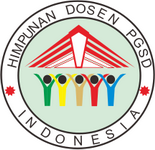ANALYSIS OF THE SCIENCE LEARNING PROCESS USING CANVA MEDIA ON STUDENT LEARNING PARTICIPATION IN GRADE IV ELEMENTARY SCHOOL
DOI:
https://doi.org/10.31949/jcp.v11i3.13538Abstract
This study aims to analyze the use of Canva digital learning media in improving student learning participation in science subjects for grade IV elementary school. The method used is Classroom Action Research with two cycles including the planning stage, action implementation, observation, and reflection. Data were obtained through observation and student learning participation questionnaires. The results of the study showed a significant increase in student learning participation after the implementation of Canva media, both in terms of physical and psychological participation. In cycle I, the average student participation reached 65%, and increased to 85% in cycle II. The use of Canva has been proven to facilitate the presentation of material visually, attractively, and interactively so that it can increase students' focus and learning motivation. The conclusion of this study is that Canva media is effective in science learning to improve student learning participation in grade IV elementary school.
Keywords:
Canva, Student learning participation, science learning, digital media, grade IV elementary school.Downloads
References
Al Haq, G. T., Sismulyasih SB, N., & Purwati, P. D. (2024). Canva-based Smart Apps Creator Media to Enhance Comprehension Skills of Informational Text for Third-Grade Students. International Journal of Elementary Education, 8(2), 385–393. https://doi.org/10.23887/ijee.v8i2.77090
Alivia Pramesti, W., & Rahmanelli. (2023). Pengaruh Media Pembelajaran Poster Digital Terhadap Hasil Belajar Geografi Siswa Kelas XI IPA di SMAN Purwodadi.
Astuti, B., & Susianti, M. (n.d.). Canva in the Classroom: Insights into High School Students’ Views on its Role in Islamic Education. PPSDP International Journal of Education, 3(2), 583–595.
Dwi Ardana, M., PGRI Madiun Dian Permatasari Kusuma Dayu, U., & PGRI Madiun Dian Nur Antika Eky Hastuti, U. (n.d.). Prosiding Konferensi Ilmiah Dasar Pengaruh Penggunaan Media Pembelajaran Canva Terhadap Keaktifan Belajar Siswa Pada Pembelajaran Tematik Kelas V Sekolah Dasar. http://prosiding.unipma.ac.id/index.php/KID
Fitriana, N., Idawati, & Mariati. (2024). Implementasi Media Pembelajaran Berbasis Canva Untuk Meningkatkan Motivasi Belajar. Jurnal Inovasi Pendidikan Dan Teknologi Informasi (JIPTI), 5(2), 375–384. https://doi.org/10.52060/jipti.v5i2.2429
Hananta Heraya, A., Zahra Husnaya, S., Studi Pendidikan Guru Sekolah Dasar, P., Keguruan dan Ilmu Pengetahuan, F., Ahmad Dahlan, U., Kapas No, J., Umbulharjo, K., Yogyakarta, K., & Istimewa Yogyakarta, D. (n.d.). Pengembangan Multimedia Interaktif Berbasis Canva pada Pembelajaran IPA Materi Bagian dan Fungsi Tumbuhan Kelas 4 SD Tegaldowo. Journal on Education, 07(01), 4148–4157.
Malau, E., Simamora, A., Siagian, A. F., Siagian, G., Studi, P., Guru, P., & Dasar, S. (2025). The Influence of Canva Media on Creative Thinking Skills in Science Learning Materials for Grade IV Students of UPTD SD Negeri 122399. Jurnal Riset Ilmu Pendidikan, 5(2), 339–346. https://doi.org/10.30596/jcositte.v1i1.xxxx
Mulyatiningsih, E. (2016). Modul Pelatihan Pendidikan Profesi Guru Fakultas Teknik, Universitas Negeri Yogyakarta.
Nisyaa, F., Suratno, & Widodo, S. T. (2025). Development of Canva-based Interactive Learning Media for Elementary School IPAS Learning. Jurnal Penelitian Pendidikan IPA, 11(1), 656–663. https://doi.org/10.29303/jppipa.v11i1.8503
Putra Pratama, M., Sampelolo, ; Rigel, Tulak, T., Kristen, U., & Toraja, I. (2023). Mengembangkan Materi Pembelajaran Interaktif Dengan Canva Untuk Pendidikan Di Smp (Vol. 7, Issue 2).
Putri, R. R., & Susanto, R. (2023). Upaya meningkatkan keaktifan belajar siswa pada mata pelajaran IPS menggunakan model two stay two stray. JRTI (Jurnal Riset Tindakan Indonesia), 8(1), 111. https://doi.org/10.29210/30033106000
Rinja Efendi, Hasibuan, A. P. G., Elvina, & Siregar, P. S. (2023). Canva Application-Based Learning Media on Motivation and Learning Outcomes. International Journal of Elementary Education, 7(2), 342–352. https://doi.org/10.23887/ijee.v7i2.53956
Saputra, A. G., Rahmawati, T., Andrew, B., & Amri, Y. (2022). Using Canva Application for Elementary School Learning Media. Scientechno: Journal of Science and Technology, 1(1), 46–57. https://doi.org/10.55849/scientechno.v1i1.4
Sari, M. I., Utari, S. D., & Arfiandhani, P. (2023). Creating English learning media using Canva: EFL students’ perspective. Teaching English as a Foreign Language Journal, 2(2), 85–96. https://doi.org/10.12928/tefl.v2i2.467
Selly Maharani, A., Umi Nasuha, S., Shilvi, D., & Maulida, R. (2024). Media Pembelajaran Sebagai Alternatif Meningkatkan Gairah Belajar. Journal BIOnatural, 11(1), 76–83. https://ejournal.stkipbbm.ac.id/index.php/bio
Sholihah, E., Supardi, A., Hilmi, I., Sunan, U., Djati, G., Stai, B., Hidayah, A., Stai, T., & Hidayah Tasikmalaya, A. (2023). Teknologi Media Pembelajaran Bahasa Arab. https://www.arrafibandung.com/
Supriyanto. (2021). Peningkatan Keterampilan Guru Dalam Pembuatan Media Pembelajaran Berbasis Canva Melalui Kegiatan In House Training Di SD Negeri 1 Babaktulung Semester 1 Tahun Pelajaran 2021/2022.
Susanti, D. A., Sultonurohmah, N., & Purwitasari, E. D. (2025). The Effectiveness of Using Canva Application as A Science Learning Media in Elementary Schools. BASICA Journal of Arts and Science in Primary Education, 4(2), 89–100. https://doi.org/10.37680/basica.v4i2.6393
Tahsinia, J., Gianistika, C., Arini, D. A., Azizah, S., Inkuiri, M., & Kritis, B. (2012). Metode Inkuiri Terhadap Kemampuan Berpikir Kritis Siswa Pada. 108(1), 39–46.
Triningsih, D. E. (2021). Penerapan Aplikasi Canva untuk Meningkatkan Kemampuan Menyajikan Teks Tanggapan Kritis Melalui Pembelajaran Berbasis Proyek. Cendekia: Jurnal Pendidikan Dan Pembelajaran, 15(1), 128–144. https://doi.org/10.30957/cendekia.v15i1.667
Yonanda, D. A., Haryanti, Y. D., Kurino, Y. D., Rosidah, A., & Sofiasyari, I. (2023). Local Wisdom-Based Pictorial Teaching Materials: A Strategy for Boosting Ecoliteracy in Elementary School Students. Profesi Pendidikan Dasar, 98–113. https://doi.org/10.23917/ppd.v10i2.4752
Published
How to Cite
Issue
Section
License
Copyright (c) 2025 Arifial Fahla Nugraha, Devi Afriyuni Yonanda, Mohamed Nor Azhari Azman

This work is licensed under a Creative Commons Attribution-ShareAlike 4.0 International License.
Authors who publish with this journal agree to the following terms:
- Authors retain copyright and grant the journal right of first publication with the work simultaneously licensed under a Creative Commons Attribution License that allows others to share the work with an acknowledgment of the work's authorship and initial publication in this journal.
- Authors are able to enter into separate, additional contractual arrangements for the non-exclusive distribution of the journal's published version of the work (e.g., post it to an institutional repository or publish it in a book), with an acknowledgment of its initial publication in this journal.
- Authors are permitted and encouraged to post their work online (e.g., in institutional repositories or on their website) prior to and during the submission process, as it can lead to productive exchanges, as well as earlier and greater citation of published work (See The Effect of Open Access).


